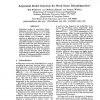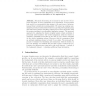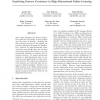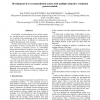155 search results - page 3 / 31 » Evaluation of a State-Based Model of Feature Interactions |
ANLP
1997
13 years 7 months ago
1997
Statistical models of word-sense disambiguation are often based on a small number of contextual features or on a model that is assumed to characterize the interactions among a set...
AMR
2007
Springer
14 years 16 days ago
2007
Springer
Abstract. Automatic structuring is one means to ease access to document collections, be it for organization or for exploration. Of even greater help would be a presentation that ad...
STTT
2010
13 years 4 months ago
2010
This article proposes a case study to evaluate the suitability of graph transformation tools for program refactoring. In order to qualify for this purpose, a graph transformation s...
JMLR
2010
13 years 1 months ago
2010
Some online algorithms for linear classification model the uncertainty in their weights over the course of learning. Modeling the full covariance structure of the weights can prov...
CW
2003
IEEE
13 years 11 months ago
2003
IEEE
Current BtoC recommendation services utilize consumers’ purchased log as criteria for selecting information, yet it includes little information of the reason why he bought the i...




